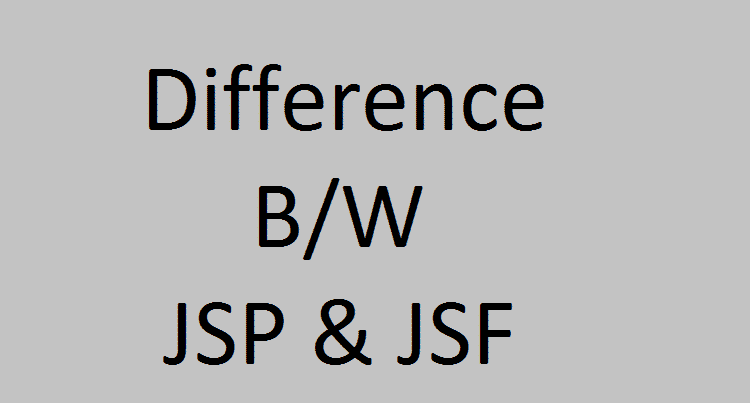JSP stands for JavaServer Pages while JSF stands for JavaServer Faces. JSP is a technology that helps developers develop dynamic web pages using technologies like HTML, XML and similar other languages. JSF is a framework that helps developers develop user interfaces for server-side applications. Both these technologies are based on Java and they are primarily used for web-based applications. JSP is more like ASP or PHP except the fact that it is based on Java which means it uses Java programming language. Both the technologies are developed by Sun Microsystems. It is interesting to note that JSP 1.x versions used JSP as the default system for templating but JSP 2.x uses Facelets instead of JSP.
The Differences –
Objective – There are fundamental differences in the objectives served by the technologies. JSP is primarily developed for creating dynamic web pages for small applications. It is very difficult to use it for large-scale applications as they are developed with a certain framework and component-based system. That is where JSF comes into the scene and it is a component-based system which is highly useful for large-scale projects. JSF uses MVC framework and hence, even the user interfaces and its components are reusable in a particular web page. While JSP is quite older and hence, fully developed, JSF is still in the developing stage and with every new version, major features are being added. For example, the latest version has added features like search expressions, push communications, extensionless URLs and likewise.
Architecture – JSF is a proper framework and that is why it is widely used in the web development industry. In technical terms is a component driven UI model system. It uses XML for view templates. FacesServlets is responsible for processing requests and sending required view templates, creating component trees, processing events and rending response to the clients. The state of the components is saved which is retrieved before creating another view. On the other hand, JSP is a request-driven technology and it is translated into servlets during the runtime. Even though it is request-driven, instead of using it independently, it can be used with view component of any server-side MVC design. The model could be JavaBeans while the controller can be Java Servlet.
Features – JSF has various multiple core features that are not present in JSP. The features present in JSF makes it suitable for presentation-type applications whereas JSP is more suitable for service-related applications. Ajax is one of the most popular UI designing technologies in today’s world and only JSP is compatible with Ajax. As a matter of fact, it is its integration with Ajax that makes it more popular than JSP.
Why Is JSF Better Than JSP?
The main difference between JSP and JSF lies in the way they operate. It is important to understand the working and flow of the two for the same web application to understand the differences. In JSP, one component has minimal impact on the other component. Therefore, you can create new views without having to write the model. Therefore, the application can be more flexible. But when it comes to complication web applications, it is difficult to maintain the structure as it is the case with JSP while developing small-scale applications. There can be code duplication and the structure can become a mess and maintenance can be difficult. Since JSP is a core technology, you can have different developers for different components but you have to be careful when it comes to integration as it can get messed up. That is why big companies avoid JSP for large-scale applications and there could be a lot of bugs and errors after the integration.
On the other hand, JSF can be divided into six phases so f development. The integration of components is seamless as it is a component-based technology and designed for large-scale applications. You can create and restore views that are used for showing information to the clients. You can update values as per you requirements without major changes. You can process validations and data type conversions like never before. Similarly, you can invoke applications to fulfill any request and render responses.
It is safe to say that JSP is the past and JSF is the future. But it is important to learn JSP first before you can try your hand in JSF. Therefore, in the training session, JSP is taught to the beginners before moving them to JSF which is more for industrial and powerful applications. The reason is that with JSP, you can understand the complete background process so that you can develop advanced applications with all the shuttle features not only with JSP but also with JSF.
If you want to develop UI for a modern enterprise application, there is no alternative to JSF for its feature-rich application. A common analogy is JSP is like an economic car for small web applications without many complications, while JSF is a luxury car designed to handle complication structures smoothly.

